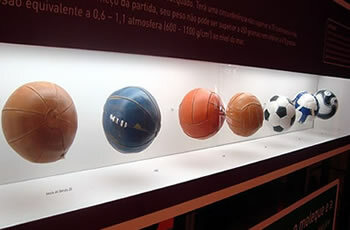The match begins and there it is: in the center of the stadium, in a few seconds, it receives the kick-off and from then on the kicks become frequent. There are several passes between pushing, dribbling, fouls, everything to put her in one place, on GOOOOOOOL!!!
Do you know who we're talking about? From the soccer ball, the No. 1 partner of stars like Pelé, Maradona, Zico, Ronaldo, Kaká, etc.
After all, what makes this sporting object able to take countless kicks and keep rolling around the field elegantly? The search for the resistance of the football symbol began in the last century. Now follow the evolution of the soccer ball, as different materials were being tested for its manufacture, so that it would not suffer any change in weight, measure and shape during the match.

Old and modern balls
• In 1884, Charles Miller brought the first ball to roll on Brazilian football fields from England. The raw material used was animal origin, the balls were made of tanned leather (the famous capotão) and the air chamber was an ox bladder.
• In 1958, at the first World Cup in which Brazil was champion, the ox bladder gave way to the rubber inner tube. But on rainy days, here's the problem: the fields were full of mud and the balls, still made of leather, were soaked until they weighed twice as much as normal.
• Even in 1970, the year Brazil became three-time champions, the balls were still made of leather.
• It was only in 1994 that balls began to lighten, thanks to the presence of polymers. Polyurethane (highly durable and lightweight) was used as a coating and polystyrene was used in the inner layers, the chambers were made of latex. It was by kicking this ball that Brazil reached the four-time World Cup championship that same year.
• In the 2002 World Cup, more polymers were part of the ball's production: under the polyurethane coating, ten layers of polystyrene were used and butyl rubber was used in the chamber. Another polymer, Kevlar, was used to stitch the ball.
• In 2004 technology arrived to innovate. The segments of the ball used in the Athens Olympics were joined by thermal bonding instead of seams.
Do not stop now... There's more after the advertising ;)
By Líria Alves
Graduated in Chemistry
Brazil School Team
See more!
bulletproof polymer
Chemistry Curiosities - Chemistry - Brazil School
Would you like to reference this text in a school or academic work? Look:
SOUZA, Líria Alves de. "Soccer Ball: From Capotão to Polyurethane"; Brazil School. Available in: https://brasilescola.uol.com.br/quimica/bola-futebol-capotao-ao-poliuretano.htm. Accessed on June 28, 2021.


